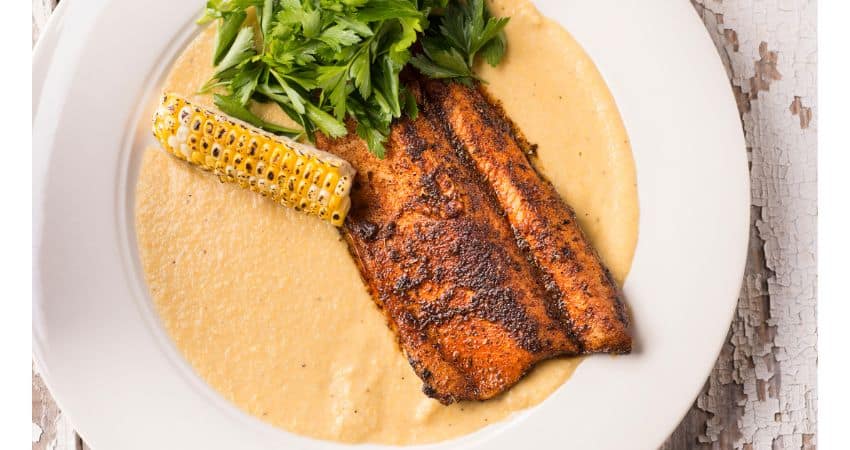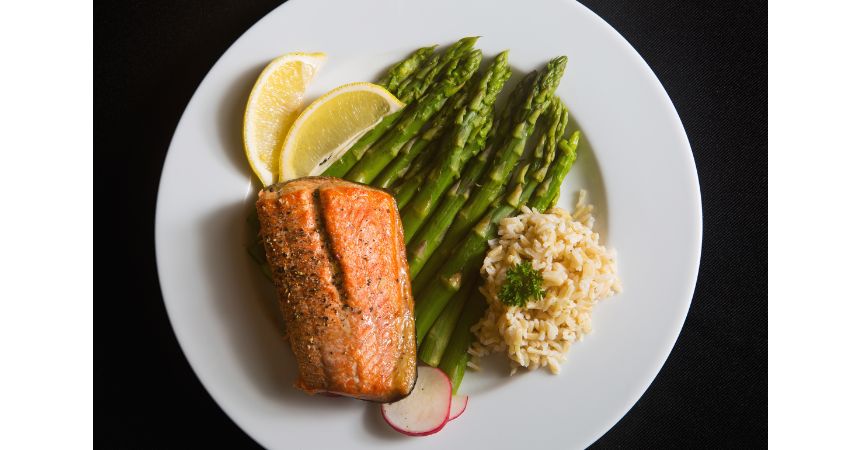Trout vs Salmon: Is One More Healthier Than The Other?
I took a look at trout and salmon side by side to see which is healthier. Here’s what I found.
Salmon is healthier than trout because it almost has twice the number of omega-3 fatty acids. In addition, salmon contains more vitamins C and B-6. Although both types of fish are considered healthy and recommended by the Dietary Guidelines for Americans.
This article will inform you about the differences in the major nutrients like omega-3, B vitamins, calories and potassium. In addition, I’ll explain what types of salmon and trout are the healthiest and how often you should eat them per week.
Which Is More Healthy, Trout or Salmon?

As a Certified Health Coach many clients ask me about food comparisons including salmon and trout. Therefore, I have researched this topic in the past and present. I also include seafood in my nutrition plan a few times per week. Let’s examine the two closely.
Let’s start the comparison by listing the important nutrients of each fish side by side in the table below.
| Nutrient | Salmon, Farmed/Cooked (3.5 Ounces) |
Trout, Farmed/Cooked (3.5 Ounces) |
| Calories | 206 | 169 |
| Fat | 12.3 g | 7.2 g |
| Protein | 22.1 g | 24.3 g |
| Omega-3 | 2,260 mg | 1,236 mg |
| Omega-6 | 666 mg | 949 mg |
| B-6 | 0.6 mg | 0.4 mg |
| B-12 | 2.8 mcg | 5.0 mcg |
| Vitamin C | 3.7 mg | 3.3 mg |
| Vitamin A | 50.0 IU | 287 IU |
| Niacin | 8.0 mg | 8.8 mg |
| Folate | 34.0 mcg | 24.0 mcg |
| Potassium | 384 mg | 441 mg |
| Magnesium | 30.0 mg | 32.0 mg |
| Phosphorus | 252 mg | 266 mg |
| Calcium | 15.0 mg | 86.0 mg |
| Zinc | 0.4 mg | 0.5 mg |
| Selenium | 41.4 mcg | 15.0 mcg |
What really separates the two and gives salmon the edge over trout is the number of omega-3 fatty acids1. What makes omega-3s so important for your health?
Omega-3 fatty acids are considered essential because your body doesn’t make them and the only way to get them is from your diet.
Omega-3s have been shown in studies to reduce inflammation, improve artery health, lower blood pressure and reduce the risk of cancer2.
Omega-3 is more important, studies have shown people who consume more omega-3 and less omega-6 enjoy more healthy years ((National Center for Biotechnology Information: Does-dependent consumption of farmed Atlantic salmon (Salmon salad) increases plasma phospholipid n-3 fatty acids differentially)).
More people already consume too much omega-6, therefore salmon containing less of it is an advantage ((National Center for Biotechnology Information: Lipid composition and contaminants in farmed and wild salmon)).
In 2019, the Journal of the American Heart Association, published a study from an updated study by JAMA Cardiology found that fish omega-3 supplements lowered risk for heart attacks and death from coronary heart disease3.
Although salmon is considered healthier, trout is still considered a healthy fish and provides almost the same magnesium, phosphorus, zinc, niacin and protein. In addition, trout contains more calcium, vitamin A, vitamin B-12 and less calories4.
The Dietary Guidelines for Americans5 list both salmon and trout in their list of best fish choices to eat.
If you’re interested about how Rainbow Trout compared to salmon, check out my article, Rainbow Trout vs Salmon: Is One Better?

The Healthiest Salmon and Trout Fish To Eat
The Healthiest Salmon Fish To Eat
While I’ve established how healthy salmon is, there are different kinds of salmon.
The healthiest salmon fish to eat is wild-caught Alaskan king or sockeye salmon because they have the healthiest oil profile beneficial for heart health. Wild-caught is better than farm raised because it has less pollutants and more healthy fats.
The Healthiest Trout To Eat
Therefore, how about trout?
The healthiest trout to eat is wild-caught freshwater trout. Freshwater trout is listed as one of the best choices of seafood to eat because it has low mercury levels. Two to three servings a week of seafood is recommended.
Seafood Containing Mercury
The FDA has made a list of fish, and which ones are the best choices, good choices and ones to avoid6. They determined this by nutrition and the content of mercury contained in the fish.
The best choices of seafood containing the least mercury included salmon and trout.

Canned Salmon and Trout
As you may know, canned fish is already cooked. Fish is typically steamed before it is canned. Canning the fish allows no air to get to the fish at all, and as a result, it can last almost forever. Learn more about canned salmon in my article, Frozen Salmon vs Canned Salmon: Which is Healthier?
The process of steaming food is known to remove approximately 10% to 15% of the nutrients in the food. However, this is fairly insignificant.
Reservations regarding canned fish are based on the early days of canned goods. Berkeley University Wellness ((Berkely Wellness: Salmon: What’s in the Can?)) applauds canned salmon and its health benefits7 but cautions against the following:
- Omega-3s: Regular canned salmon with skin and bones provide about 2000 milligrams of omega-three per half-cup. Skinless and boneless salmon only contains about 650 milligrams for the same net weight amount.
- Calcium: Canned salmon is an excellent source of calcium if you eat the bones. It also provides vitamin D. Choosing the deboned premium options is cheating yourself of 200mg of calcium per 4oz serving.
- Farmed vs. wild-caught. There are some concerns regarding farmed salmon and polychlorinated biphenyls (PCBs). One should choose wild-caught salmon in cans.
- Sodium: Doctors point out the high sodium levels in canned fish. They suggest rinsing the fish before consuming to reduce the sodium levels.
Eating Fish Everyday
Can I eat salmon everyday?
Salmon and trout are quite delicious and healthy. For this reason, you may find yourself eating it more often ((USDA: Eat fish! Which Fish? That Fish! Go Fish!)). Therefore, you may be wondering whether you can eat salmon everyday.
Salmon should not be eaten everyday. The Dietary Guidelines for Americans recommends eating 2-3 servings of seafood a week. Each serving consists of approximately four ounces.
Can you eat trout everyday?
Trout should not be eaten everyday because the Dietary Guidelines for Americans recommends eating eight ounces of seafood a week. The recommendation is two to three servings per week and not everyday.
The same rules applying to salmon apply to trout. And as long as you don’t eat more than eight ounces a week, you should be fine. The FDA’s recommendation of eight ounces a week is all seafood combined, not just trout or salmon individually.
Is Trout or Salmon Better for Weight Loss?
It’s known you should consume less calories than you burn to lose weight. Keeping track of the calories in what you eat and creating a meal plan is important to get a clear picture of how to lose weight.
The total number of calories a person needs each day depends on the following factors:
- Age
- Sex
- Height
- Weight
- Amount of physical activity
Therefore, which has fewer calories, trout or salmon?
Trout contains 169 calories and salmon 206 calories per 3.5 ounces. Therefore, eating trout instead of salmon lowers the number of calories consumed in each serving making it better for weight loss.
Eating healthy salmon and trout alone won’t accomplish weight lose if the remaining nutrition doesn’t consist of healthy foods.
If you have any questions to ask me about this article don’t hesitate to comment below or email us. You can find an email on our contact page.
Read Next – More Fish vs Fish Articles!
Steelhead vs Salmon: Which Is Better?
Sea bass vs Salmon: Which Is Better?
Tilapia vs Salmon: A Comparison
Tuna vs Salmon: Which Is Better?
- NutritionData: Salmon [↩]
- National Center for Biotechnology Information: Risk and benefits from consuming salmon and trout: a Canadian perspective [↩]
- National Center for Biotechnology: Marine Omega-3 Supplementation and Cardiovascular Disease [↩]
- NutritionData: Trout [↩]
- USDA: Dietary Guidelines [↩]
- FDA: Advice about Eating Fish [↩]
- Harvard Health Publishing: Is canned fish good for the heart? [↩]
